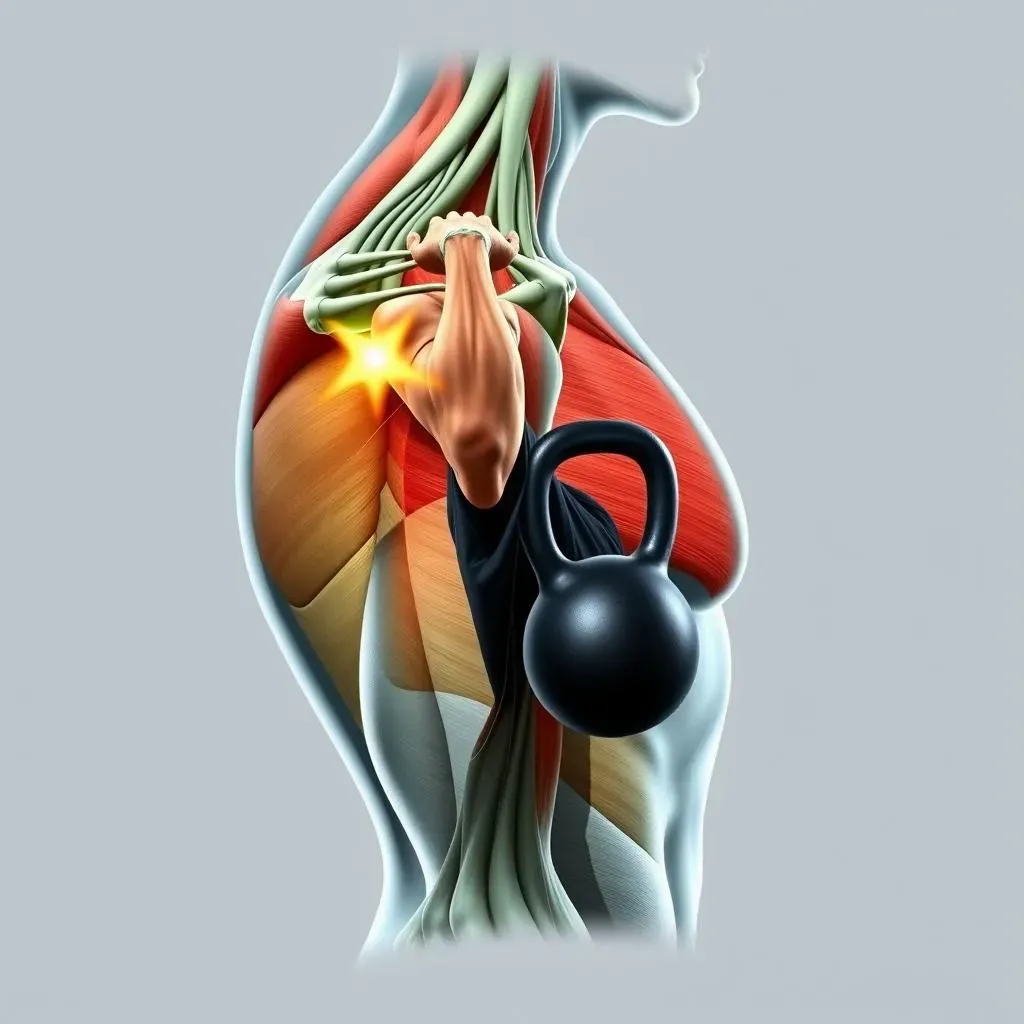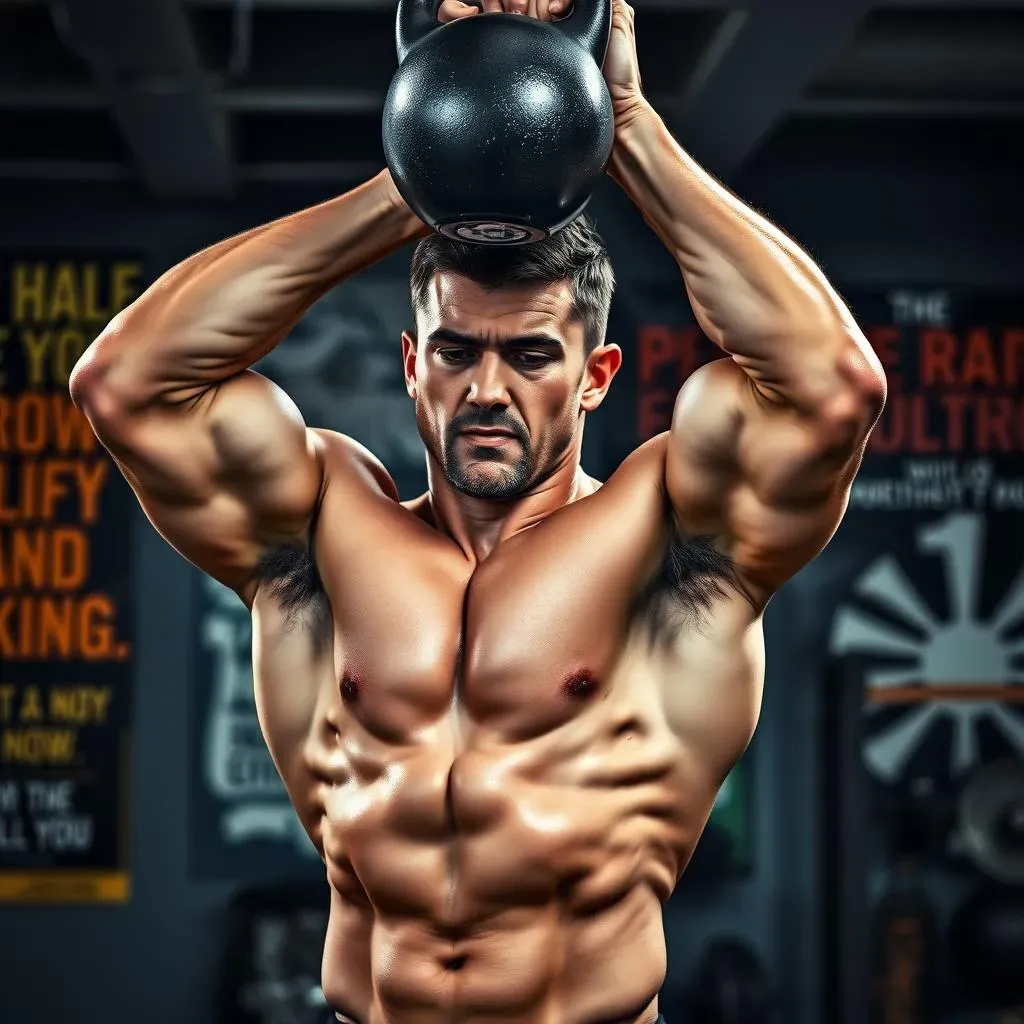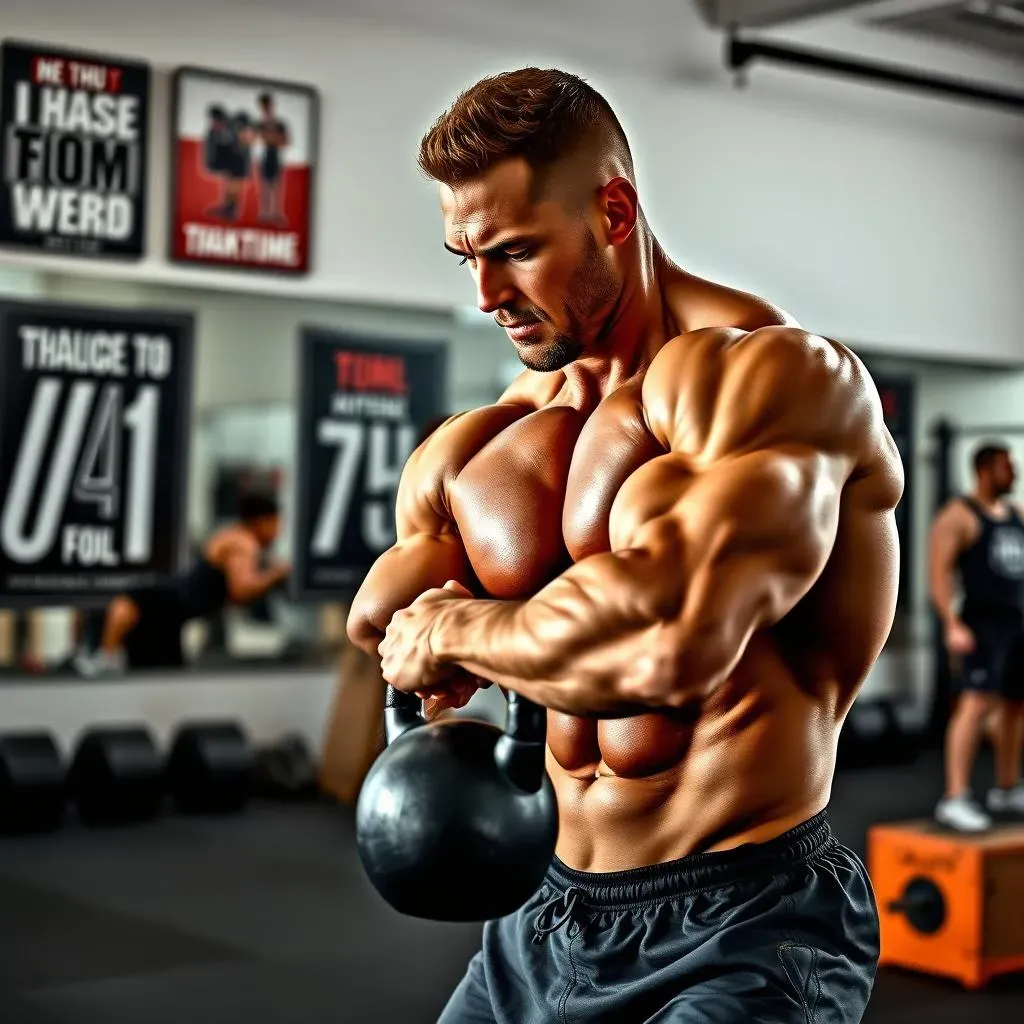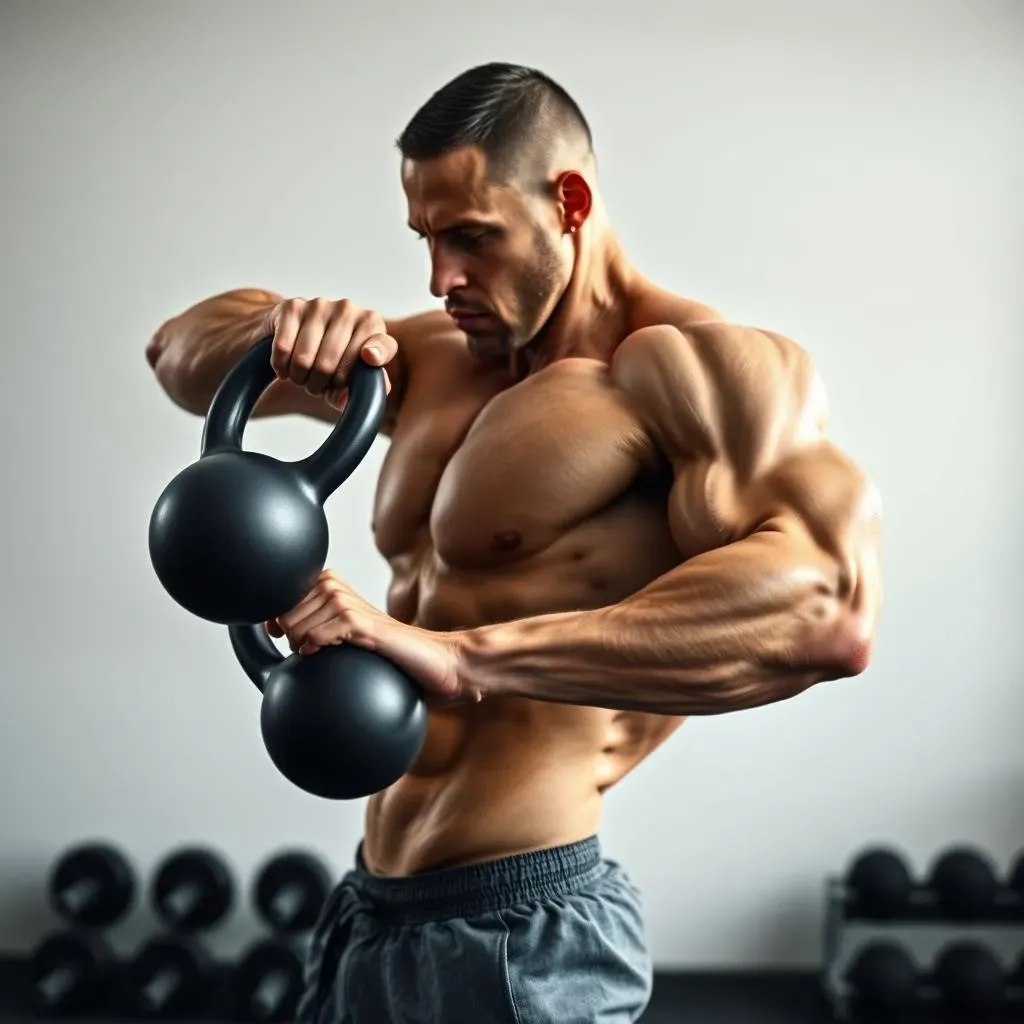Table of Contents
Ready to sculpt some serious shoulder definition? If you're into bodybuilding and looking for a dynamic way to build strength and size, a kettlebell shoulder workout bodybuilding routine might just be your new secret weapon. Kettlebells aren't just for swings and squats; they're incredibly effective for targeting those deltoids and rotator cuffs, offering a unique challenge that dumbbells and barbells can't always replicate.
Understanding Shoulder Anatomy for Effective Kettlebell Workouts

Understanding Shoulder Anatomy for Effective Kettlebell Workouts
The Core Players: Deltoids and Rotator Cuff
Before you start swinging those kettlebells, let's get acquainted with the key players in your shoulder's anatomy. The deltoids, those rounded muscles capping your shoulder, are what give you that impressive, sculpted look. They're divided into three heads: anterior (front), lateral (side), and posterior (rear). Each head contributes to different movements, like lifting your arm forward, sideways, and backward, respectively. But don't forget the rotator cuff! This group of four muscles—supraspinatus, infraspinatus, teres minor, and subscapularis—stabilizes the shoulder joint, allowing for a wide range of motion and preventing dislocations. Think of them as the unsung heroes of every shoulder movement.
Now, why is this knowledge crucial for kettlebell training? Because understanding which muscles are working during each exercise allows you to target them more effectively. Plus, knowing the rotator cuff's role emphasizes the importance of proper form and controlled movements to avoid injury. Kettlebells, with their offset center of gravity, can be particularly demanding on the shoulder joint, so respecting its anatomy is key to a long and productive training career.
Muscle Group | Primary Function | Kettlebell Exercises |
|---|---|---|
Anterior Deltoid | Shoulder flexion (lifting arm forward) | Kettlebell Front Raises, Kettlebell Shoulder Press |
Lateral Deltoid | Shoulder abduction (lifting arm sideways) | Kettlebell Lateral Raises, Kettlebell Upright Rows |
Posterior Deltoid | Shoulder extension (lifting arm backward) | Kettlebell Face Pulls, Kettlebell Rows |
Rotator Cuff | Shoulder stabilization and rotation | Kettlebell Arm Bar, Kettlebell Turkish Get-Up |
Beyond the Basics: Scapular Movement and Stability
While the deltoids and rotator cuff get most of the attention, the scapula (shoulder blade) plays a vital role in shoulder function. Proper scapular movement—protraction, retraction, elevation, and depression—ensures that the shoulder joint moves smoothly and efficiently. When the scapula doesn't move correctly, it can lead to impingement, instability, and pain. Kettlebell exercises, particularly those that involve overhead movements, can help improve scapular control and stability, but only if performed with proper technique.
Consider the kettlebell Turkish Get-Up, for example. This complex movement requires coordinated scapular movement throughout the entire exercise, strengthening the muscles that stabilize the shoulder blade and promoting healthy shoulder mechanics. By focusing on scapular stability during your kettlebell workouts, you're not just building bigger shoulders; you're building healthier, more resilient shoulders that can handle the demands of heavy lifting and everyday life. It's about building a solid foundation for long-term shoulder health and performance.
Top 5 Kettlebell Exercises for Shoulder Development in Bodybuilding

Top 5 Kettlebell Exercises for Shoulder Development in Bodybuilding
Kettlebell Clean and Press: The King of Compound Movements
If you could only pick one kettlebell exercise for overall shoulder development, the Clean and Press would be a top contender. This movement works pretty much every muscle in your shoulder, from the anterior deltoid during the press to the lateral and posterior deltoids for stability. Plus, you're getting a full-body workout as you clean the kettlebell up to the rack position. The clean itself engages your traps and rhomboids, contributing to upper back strength and stability – essential for healthy shoulders. Think of it as building a fortress around your shoulder joint, brick by brick.
Proper form is key here. Start with the kettlebell a few inches in front of you, hinge at the hips, and keep your back straight. As you clean the kettlebell, explode upwards, using your hips and legs to generate power. Rack the kettlebell in a stable position, elbow tucked in close to your body. From there, press the kettlebell overhead, fully extending your arm. Control the weight on the way down, and repeat. Master the technique with lighter weights before going heavy. Your shoulders will thank you.
I remember when I first started doing kettlebell clean and presses, I was all over the place. My form was sloppy, and my shoulders felt like they were going to pop out of their sockets. But after slowing down, focusing on each phase of the movement, and gradually increasing the weight, I saw a huge improvement in my shoulder strength and stability. It's a humbling exercise, but the rewards are well worth the effort.
Muscle Group | Benefit | Sets/Reps |
|---|---|---|
Deltoids | Strength and size | 3-4 sets of 8-12 reps |
Traps and Rhomboids | Upper back stability | As part of the clean |
Core | Stabilization | Engaged throughout the movement |
Kettlebell Bottoms-Up Press: Stability is the Name of the Game
Want to challenge your shoulder stability like never before? The Bottoms-Up Press is your answer. Holding the kettlebell upside down, with the bell facing the ceiling, requires immense focus and control. This variation forces your rotator cuff muscles to work overtime to keep the weight stable. It's not about lifting heavy; it's about maintaining perfect form and preventing the kettlebell from wobbling. Trust me, even a light kettlebell will feel like a monster when held bottoms-up.
Start with a light kettlebell. Clean the kettlebell into the rack position, then carefully flip it so the bell is facing up. Keep your wrist straight and your elbow tucked in close to your body. Press the kettlebell overhead, maintaining a tight grip and a straight wrist. The key is to focus on keeping the kettlebell stable throughout the entire movement. If you start to wobble, lower the weight and try again. It's a great way to improve your proprioception (your sense of body position) and build incredible shoulder control.
I've seen seasoned lifters humbled by the Bottoms-Up Press. It's a different beast altogether. I started with a tiny 8kg kettlebell, and even that felt challenging at first. But with consistent practice, I gradually increased the weight and my shoulder stability improved dramatically. It's now one of my favorite exercises for injury prevention and overall shoulder health.
Kettlebell Turkish Get-Up: The Ultimate Test of Shoulder Strength and Mobility
The Turkish Get-Up (TGU) is more than just an exercise; it's a full-body movement that challenges your strength, mobility, and coordination. The shoulder plays a crucial role in stabilizing the weight overhead as you transition from lying to standing. It demands constant engagement from the rotator cuff and deltoids, building incredible endurance and stability. Plus, the TGU improves scapular control, core strength, and overall body awareness.
This is a complex exercise, so start with a light kettlebell or even just your shoe. Lie on your back with the kettlebell in one hand, arm extended towards the ceiling. Bend the knee on the same side as the kettlebell. Use your other arm to help you roll onto your elbow, then onto your hand. From there, bridge your hips up, sweep your straight leg behind you, and come into a lunge position. Finally, stand up, maintaining the kettlebell overhead. Reverse the movement to return to the starting position. Take your time, focus on each step, and don't be afraid to break the movement down into smaller parts.
The TGU can be intimidating at first, but it's an incredibly rewarding exercise. When I first started learning the TGU, it took me weeks to master the technique. But once I did, I felt a newfound sense of strength and control in my body. It's not just about lifting weight; it's about moving with purpose and precision. And that's what makes it such a valuable exercise for shoulder health and overall fitness.
Crafting Your Kettlebell Shoulder Workout Routine for Bodybuilding

Crafting Your Kettlebell Shoulder Workout Routine for Bodybuilding
Choosing the Right Exercises for Your Goals
So, you're ready to build a kettlebell shoulder workout bodybuilding routine? Awesome! First, you've got to figure out what you're aiming for. Are you looking to pack on size, improve strength, or enhance endurance? Your goals will dictate which exercises you prioritize. For mass building, focus on compound movements like the Clean and Press and Overhead Press. For strength, incorporate Bottoms-Up Presses and heavier swings. And for endurance, consider higher rep sets of Turkish Get-Ups and lighter presses. It's all about tailoring the workout to your specific needs.
Don't be afraid to experiment and see what works best for you. Some people respond well to high-volume training, while others thrive on lower reps with heavier weights. The key is to listen to your body and make adjustments as needed. And remember, consistency is king. Stick to your routine, track your progress, and celebrate your successes along the way. Building a great physique takes time and effort, but it's definitely achievable with the right approach.
Goal | Exercise Focus | Rep Range |
|---|---|---|
Mass Building | Clean and Press, Overhead Press | 8-12 reps |
Strength | Bottoms-Up Press, Heavy Swings | 5-8 reps |
Endurance | Turkish Get-Ups, Lighter Presses | 12-15 reps |
Structuring Your Weekly Kettlebell Shoulder Sessions
Now that you've chosen your exercises, let's talk about how to structure your weekly routine. I recommend hitting your shoulders with kettlebells 2-3 times per week, allowing for adequate recovery between sessions. You can either dedicate an entire workout to shoulders or incorporate kettlebell shoulder exercises into a full-body routine. If you're doing a dedicated shoulder workout, consider splitting it into two different focuses: one day for pressing movements and another for stability and mobility exercises. This allows you to target different aspects of shoulder function and prevent overuse injuries.
When designing your routine, think about exercise order. Start with the most challenging compound movements when you're fresh, and then move on to isolation exercises and stability work. For example, you might start with the Clean and Press, followed by Bottoms-Up Presses, and then finish with Turkish Get-Ups. This approach ensures that you're giving your all to the most demanding exercises and maximizing your overall results. Remember, quality over quantity. Focus on proper form and controlled movements, and the gains will follow.
Progressive Overload: The Key to Continuous Growth
To keep making progress, you need to consistently challenge your muscles. That's where progressive overload comes in. This means gradually increasing the demands on your body over time, whether by adding weight, increasing reps, or modifying the exercise. With kettlebells, you can increase the weight incrementally, switch to a more challenging variation, or decrease your rest periods. For example, if you can easily perform 12 reps of the Kettlebell Overhead Press with a certain weight, it's time to bump up to the next size. Or, you could try performing the exercise with a slower tempo or adding a pause at the bottom of the movement. There are countless ways to make your workouts more challenging and keep your muscles growing.
Another important aspect of progressive overload is tracking your progress. Keep a workout journal and record your sets, reps, and weights. This will allow you to see how far you've come and identify areas where you need to improve. It's also a great way to stay motivated and accountable. Seeing your progress on paper can be a powerful reminder of your hard work and dedication. So, grab a notebook, start tracking your workouts, and watch your shoulder strength and size soar!
Advanced Kettlebell Techniques for Maximizing Shoulder Growth and Strength

Advanced Kettlebell Techniques for Maximizing Shoulder Growth and Strength
Unilateral Training: Level Up Your Stability and Strength
Ready to kick your kettlebell shoulder workout bodybuilding up a notch? Let's talk about unilateral training. This means focusing on one arm at a time, and it's a game-changer for shoulder development. Why? Because it forces your core and stabilizer muscles to work overtime to prevent rotation and maintain balance. Think about it: when you're pressing a kettlebell overhead with one arm, your entire body has to fight to stay upright. This not only builds incredible shoulder stability but also strengthens your core and improves your overall body awareness.
Exercises like the Single-Arm Kettlebell Clean and Press, Single-Arm Bottoms-Up Press, and Single-Arm Turkish Get-Up are all fantastic choices for unilateral shoulder training. Start with lighter weights and focus on maintaining perfect form. Pay attention to how your body feels and make adjustments as needed. You might be surprised at how much more challenging these exercises become when performed unilaterally. But trust me, the rewards are well worth the effort. You'll build stronger, more resilient shoulders that can handle anything life throws your way.
Exercise | Benefits | Tips |
|---|---|---|
Single-Arm Clean and Press | Increased core engagement, improved stability | Focus on anti-rotation, maintain a tight core |
Single-Arm Bottoms-Up Press | Enhanced shoulder stability, improved proprioception | Keep wrist straight, control the wobble |
Single-Arm Turkish Get-Up | Full-body strength and mobility, shoulder endurance | Break down the movement, focus on each step |
Tempo Training: Control the Eccentric for Maximum Growth
Want to maximize muscle growth and strength gains? Then you need to master tempo training. This involves manipulating the speed of each phase of the exercise: the eccentric (lowering), isometric (pause), and concentric (lifting). By slowing down the eccentric phase, you increase the time under tension, which is a key driver of muscle hypertrophy. Plus, controlling the eccentric helps you build strength throughout the entire range of motion and reduces your risk of injury.
For example, when performing the Kettlebell Overhead Press, try lowering the weight slowly over a count of 3-4 seconds. Pause briefly at the bottom, and then press the weight back up explosively. This will not only make the exercise more challenging but also force your muscles to work harder and adapt. You can also experiment with isometric holds at different points in the range of motion. For example, pause halfway down during the eccentric phase or hold the weight at the top for a few seconds. These variations will challenge your muscles in new ways and promote further growth and strength gains.
Kettlebell Complexes: Combining Exercises for a Killer Shoulder Burn
Looking for a way to crank up the intensity of your shoulder workouts? Try kettlebell complexes. A complex involves performing a series of exercises back-to-back without rest. This not only builds strength and endurance but also improves your cardiovascular fitness and burns a ton of calories. Plus, complexes are a great way to challenge your coordination and mental toughness.
Here's an example of a kettlebell shoulder complex: Start with 5 reps of the Kettlebell Clean and Press, followed by 5 reps of the Kettlebell Front Raise, and then finish with 5 reps of the Kettlebell Lateral Raise. Perform all three exercises back-to-back without rest, and then take a short break before repeating the complex. You can adjust the exercises, reps, and rest periods to suit your fitness level and goals. Just be prepared for a serious shoulder burn!
Unleash Your Shoulder Potential with Kettlebell Training
Incorporating a kettlebell shoulder workout into your bodybuilding regimen offers a potent blend of strength, stability, and functional fitness. By mastering the five exercises outlined – the Kettlebell Swing, Single-Arm Kettlebell Swing, Kettlebell Shoulder Press, Kettlebell Vertical Row/Upright Row, and Single-Arm Kettlebell Z Press – you'll not only build impressive shoulder mass but also enhance your overall athleticism. Remember to prioritize proper form, gradually increase the weight, and listen to your body to avoid injury. So, grab a kettlebell, get to work, and watch your shoulder strength and size soar!